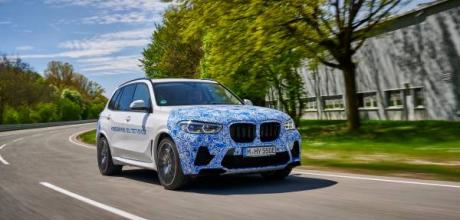BMW tests hydrogen fuel cell
BMW is testing its hydrogen fuel cell drive train on European roads ready for deployment in an X5 sized vehicle in 2022.
Hydrogen fuel cell has long been mooted as an alternative to plug-in hybrid systems and battery-electric vehicles – BMW is among many manufacturers testing the technology. BMW has now begun testing near-standard vehicles equipped with its hydrogen fuel cell drive trains in everyday conditions on European roads. Prototypes of the BMW i Hydrogen NEXT will examine how effectively the CO2-free drive train, model-specific chassis technology and vehicle electronics systems work together under real-life conditions.
The BMW i Hydrogen NEXT is a pure electric vehicle that uses hydrogen as fuel by converting it into electricity and storing it in a fuel cell. The recently launched testing programme will pave the way for BMW to present a small-series model with the technology, developed on the basis of the X5, in late 2022. Extensive field testing of these vehicles will provide practical experience in the use of this sustainable drive technology.
Fitting within BMW's flexible drive train strategy, the technology could become an attractive alternative to battery-electric drivetrains – especially for customers who do not have access to electric charging infrastructure or who frequently drive long distances. The other benefit of the technology is that it plays to our existing habits of filling a vehicle at a feeling station and could make use of existing infrastructure, and also it allows driving for extended distances. Just like the fuel tank of a conventional combustion-engine car, the hydrogen tank can also be filled within three to four minutes with a fuel that ensures a range of several hundred miles in all weather conditions.
The BMW i Hydrogen NEXT uses fuel cells designed in cooperation with Toyota – two heads are better than one after all. The individual cells come from Toyota, the fuel cell stack and drive system are original BMW developments. The partnership was established in 2013 and seeks to ensure everyday practicality and scalability of hydrogen fuel cell technology for use in each company’s production vehicles via an exchange of experience. The BMW i Hydrogen NEXT combines hydrogen fuel cell technology with fifth-generation BMW eDrive technology – as found in the iX3 and soon, the BMW iX and BMW i4, too.
How does hydrogen fuel cell work?
Energy is generated in the fuel cell as the result of a chemical reaction between the hydrogen carried by the vehicle and oxygen in the air. This delivers an electrical output of 125kW/170hp. An electric converter located below the fuel cell adjusts its voltage to that of the electric motor, which powers the vehicle.
Energy stored in a performance buffer battery is also used for dynamic acceleration – for example short bursts of speed for overtaking. As a result, the system delivers an output of 275kW/374hp – interestingly that matches exactly the most powerful six-cylinder in-line petrol engine currently used in BMW models. The energy stored in the performance buffer battery is generated by recovering energy from coasting and braking phases. The hydrogen needed to supply the fuel cell is stored in two 700-bar tanks made of carbon-fibre reinforced plastic (CFRP), which together hold six kilograms of hydrogen. The precisely controlled reaction with oxygen in the fuel cell generates electricity, water vapour is the only emission produced by the drive train – you can even drink it. Seriously!


